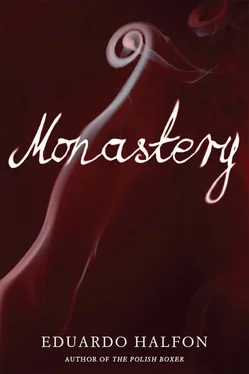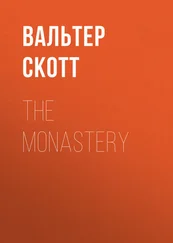We crossed St. Nicholas Avenue. That way, she said, signaling with a glance, is St. Nick’s Pub, Harlem’s legendary jazz club. Ah, the old Poospatuck, I said, and she, looking askance, almost complicit, threw me a half smile. I knew something about the history of St. Nick’s Pub. I knew that when it first opened, in the thirties, it was called the Poospatuck Club, after a tribe native to New York. Later, in the forties, it was named the Rendezvous, by its new owner, Charles Luckeyth Roberts, or Luckey Roberts, the great stride pianist, whose span on the keys was so wide and so quick, it’s been said, because he had the skin between his fingers surgically cut. Later, in the fifties, adding opera to the repertoire, the new owners called it the Pink Angel — because, it’s been said, it was a popular haunt for homosexual men. And lastly, since the sixties, St. Nick’s Pub.
We came to Edgecombe Avenue. On the far side of the road was a small strip of trees. On the far side of the trees was a highway. From the far side of the highway, in the distance, we could perhaps hear the gentle flow of the Harlem River. We turned right. I didn’t say anything, hoping she would talk more, simultaneously eager to arrive and wanting never to arrive. Almost at once, she stopped at the black door of a huge classical building, and gave me a look. A look filled with something. Kindness, perhaps. Weariness, perhaps. The skin on her face, because of the humidity or because of the light coming from an ancient streetlight, seemed to burn in the night. She said: Marjorie Eliot says she started to host jazz concerts in her apartment, after the death of her son, as a way of surviving Sundays.
NUMBER 555 EDGECOMBE AVENUE has many names. Some call it the Paul Robeson Residence. Others, the Roger Morris Building. Others, the Triple Nickel. Still others, Count Basie Place. Built in 1916, for its first twenty-five years it was a segregated residence: whites only. But around 1939, when Harlem’s character changed, so did the rules and restrictions at 555 Edgecombe Avenue, and it became the residence of distinguished and famous members of Harlem’s African-American community. Like musician Count Basie. Composer and pianist Duke Ellington. Sax player Coleman Hawkins. Writer Langston Hughes. Judge (and the first African-American on the Supreme Court) Thurgood Marshall. Baseball player (and the first African-American in the major leagues) Jackie Robinson. Boxer (and the first African-American on the pro golf circuit) Joe Louis. Singer Lena Horne. Writer Zora Neale Hurston. Actor and political activist Paul Robeson. Pianist Marjorie Eliot.
Go on in, child, go on in.
She had taken out a bunch of keys, had opened the heavy black iron door.
I closed my umbrella and went quickly inside as she held the door for a group of tourists, then guided them toward the elevator, told them to go on up to the third floor. I stood looking at the lobby: large, ostentatious, the whole place clad in green, gray, and beige marble, with friezes sculpted in plaster and meticulously adorned in gold leaf. On the walls were poorly maintained gaudy bas-reliefs of chubby children at play, and chubby children with flutes, and chubby children riding on the backs of goats. There was a huge stained-glass window in the ceiling, also in poor condition. When I was a little girl, she said to me, looking upward and shaking the water from her raincoat, they decided to paint black over it and cover it with wood planks. She took off her gloves. She took off her cloche hat. She ran a hand through her short salt-and-pepper Afro, while the pink tip of her tongue emerged and ran over her top lip, then her bottom lip, maybe licking away the raindrops. To protect the window, she said. From an expected atomic bomb.
We walked over to the elevator. And as we waited for it, I imagined her as a little girl, growing up there, playing and running in the lobby and in the corridors and surrounded by all the gilded children and all the famous residents of the building and always wearing her bloodred boots.
Have you known Marjorie a long time? I asked. Yes, a long time, she said. She was a good friend of my parents. I considered asking who her parents were, whether they still lived there. But I thought it inappropriate. On Sundays, I help her out however I can, she said. Sometimes I set out the chairs. Sometimes I put in the blue lights. Sometimes, during the break, I serve the orange juice and cookies to the guests. Sometimes, I help a few lost souls find their way. She gave me a graceful smile. It’s my way, however small and useless, she said, of honoring the memory of a dead son. She fell silent, and it occurred to me that she’d said these last words with a different voice. Perhaps with a voice that was trembling, or hoarser, or breaking slightly. Perhaps with the restrained and false voice of a ventriloquist. And I knew then, with absolute certainty, with total conviction, that she too had lost a son.
The elevator doors opened, we stepped inside, she pressed the button, and we went up slowly, in silence. Both of us looking straight ahead, both of us looking up, both of us looking again at her bloodred boots, and feeling or imagining that we were feeling, in this space that was no space, in this small antechamber, the devastating and heroic strength of a mother for her dead son.
Suddenly, a bell rang. The doors opened. Here’s where you get out, she said, I go on to the top floor. I was a little surprised. I’d assumed that she was also going to Marjorie’s, that she’d be accompanying me to Marjorie’s, and I told her so. She shook her head. Not today, she said. Today, I survive alone.
I stepped out into the hallway. In the distance I could hear, sounding muted, muffled, the sweet and dissonant melody of a piano. I turned to the elevator, to Shasta. I thanked her. On the right, she said, apartment 3F, and hurry, child, you’re already late. The sound of the piano stopped, then silence, and gentle applause. She smiled at me with just her eyes. I held out my hand, a bit hurried and proud, perhaps wishing to defer the inevitable for a while longer. It took her a moment to understand, but then she also held out hers. And we stayed like that for a couple of seconds, maybe not even that, each of us on separate sides of the doors.
Prologue at Saint-Nazaire
I’m looking out at the submarine base.In 1940, here, in Saint-Nazaire, a port town on the French Breton coast, the German Kriegsmarine erected this enormous base for building submarines. The famous U-boats, as they are called in English, or U-Boote, in German, an abbreviation of Unterseeboote. I look down through the window and I can see, directly opposite, the gray-brown block, oblong, dismal, vast (three hundred meters long, eighteen meters tall); then I turn my gaze to the pieces of paper scattered over my desk, photocopies of the correspondence between Chekhov and his friend Pleshcheev.
It is January 1888. In a letter to poet Alexei Pleshcheev, Anton Chekhov remarks on the process of writing “The Steppe,” his first long story. He tells him that writing long things is extremely tedious and much more difficult than writing trivial things. He also tells him that, in order to earn a little money, he is considering writing something short for one of the newspapers, perhaps for the Novoye Vremya , perhaps for the Peterburgskaya Gazeta . His friend Pleshcheev writes back at once, dismayed. He tries to dissuade him. He insists that it would be a great shame to put his long story aside and write something trivial just for the money, for newspapers that are read one day, he writes, and used as wrapping paper the next.
I watch a group of children running around on the roof of the submarine base. An outing from some French school, I think, and I think about the word trivial, about the importance of the trivial in art, in literature. Isn’t the trivial, after all, the raw material of the short story writer? Aren’t anecdotes that seem trivial — that is to say, insignificant — the very clay with which the short story writer carries out his craft and shapes his art? All of life, I think, is codified in these trivial, minuscule, transparent details — details that seem not to contain anything of importance (a leaf of grass, wrote Walt Whitman, is no less than the journey-work of the stars). A great short story writer, I think as the children play on the old submarine base, knows how to make something immense of the brief, something transcendent of the insignificant, knows how to transform nothing at all into a few pages that contain everything. I recall now a story about Chopin that Ingmar Bergman told when somebody asked him why he made intimate movies, movies about couples, why he made chamber cinema instead of bigger, more epic productions. At the end of a concert, said Bergman, a lady asked Chopin a similar question — why he didn’t write operas or symphonies instead of his short preludes and nocturnes. And Chopin replied: Well, madame, mine is a small kingdom, but there I am king.
Читать дальше












